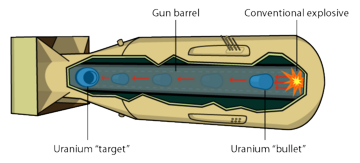John Fleck, writing in the Albuquerque Journal, reports some folks think the reliable replacement warhead program should emphasize uranium designs:
A veteran of the U.S. nuclear weapons program thinks the weaponeers should consider giving up on plutonium.
In a paper informally circulating among senior government advisers, retired Sandia National Laboratories vice president Bob Peurifoy argues that U.S. nuclear weapons designers should considerusing uranium instead.
[snip]
To those outside the nuclear weapons community, this might sound like little more than a debate about whether Coke or Pepsi makes the better cola.
But much more is at stake than an arcane question of materials science. Since the Rocky Flats nuclear weapons factory shut down in 1989, the costs, dangers and difficulties of working with plutonium have left the United States with no capability to make new nuclear bombs.
Building a replacement to make new plutonium bombs would likely cost billions of dollars. Parts made of uranium, a much less dangerous material, could easily be made at an existing weapons plant in Tennessee, Peurifoy argues.
[snip]
Heading down the path Peurifoy is suggesting would requirer thinking the nuclear weapons complex of the future, where the need for a new plutonium factory looms as a central feature.
It would also require weapons designers to abandon their lightweight, highly optimized nuclear weapon designs in the current arsenal for bigger, simpler devices.
“I’m a tractor engineer. I’m not a Ferrari designer,” Peurifoy said in an interview. “I want to pull the Ferrari out of the mudpuddle.”
Peurifoy is being careful in advancing his argument, making clear that his first choice is to stick with the arsenal the United States currently has. But as designers begin work on a new generation of “Reliable Replacement Warheads,” with plutonium the likely choice for a bomb material, Peurifoy is trying to spark a discussion of the uranium alternative.
Uranium designs can utilize either a gun-type assembly (as was dropped on Hiroshima, diagram above) or implosion (e.g. tested by the Chinese).
The gun-type assembly is insanely simple. We didn’t even bother to test the one we dropped on Hiroshima. Uranium implosion is a little more dicey, but not really—after all, the Khan network was peddling the Chinese implosion design.
Peurifoy’s proposal comes as Congress considers what sort of work will be appropriate for the Reliable Replacement Warhead Program, something about which your humble author and Stephen Young both have strong opinions.
I like the Peurifoy proposal’s Swiftian modesty. After all, if the Reliable Replacement Warhead program really is about making more reliable designs and a less toxic nuclear infrastructure—rather than rationalizing current practices—Uranium is the way to go.
If what you really want to do is get back to designing new nuclear weapons, well, then you’re a plutonium man.
In 2000, Stephen Younger—then Associate Laboratory Director for Nuclear Weapons at Los Alamos National Laboratory—proposed emphasizing lower yield, uranium weapons. The reaction from my colleagues in the arms control community, particularly Stephen Schwartz, was undertsandably tepid.
After all, Younger’s interest in arms control seemed rather like a death-bed conversion for the nuclear enterprise.
But Peurifoy is a different man, in a different time. I look forward to hearing from Schwartz—and the rest of you—on Peurifoy’s proposal.


Did you catch R Gottemoeller (CEIP Senior Assoc) on C-SPAN’s Wash Journal on Aug 14?
It was all about Iran.
If you click on the “Bush Administration” link on the C-SPAN.org homepage, it is (currently) at the top of the list.
If this proposal prompts a serious discussion, it could at the very least serve to provide some hints about who is into Reliable Warhead Replacement for the scientific challenge (or the juicy science grants, I suppose) and who has more political motives.
How small can you build a uranium bomb, anyway? Are RNEPs and other “usable” nukes out of the question if uranium is the mandated technology?
Does anyone have a list of those congresscritters who are capable of making sense of this debate?
If an alternative to a program with Pentagon/Labs inertia is to be proposed, it should rely on short sentences, and assume only the most cursory of familiarity with the topic at hand.
No offense intended to staffers who might be reading this, but this can’t be considered a high-point (and I’d argue, one of the lower points) of Congressional, um, perspicacity.